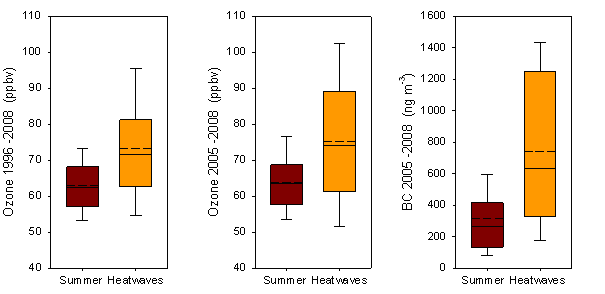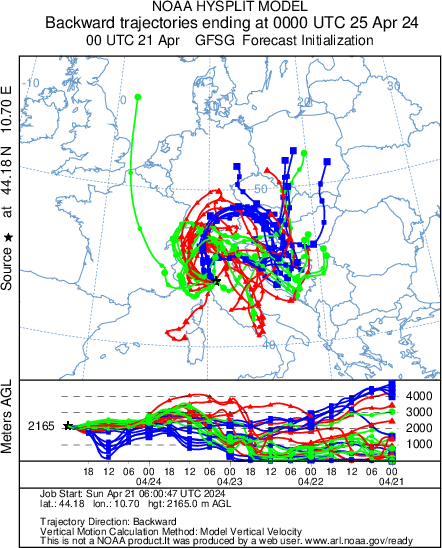Polluted air mass transport
The Mediterranean basin is a particularly sensitive region for air pollution. This is due to the elevated anthropic and natural emissions of aerosol and trace gases as well as to long-range transport of pollutants (even from other continents). In particular, during the summer season, due to the high solar irradiance, the Mediterranean basin can be affected by intense photochemical O3 events and many pollutants from the European boundary layer can be exported toward the Mediterranean free troposphere. Biomass fire events, thermally induced recirculation near the densely populated coastlines and dust plumes from Sahara can further contribute in influence atmospheric composition and air-quality in this region. For these reasons and with the goal to better evaluate the influence of these processes on the atmospheric composition variability, polluted air-mass transport phenomena are investigated at ICO-OV. As being located at the South borderline of the polluted Po basin (see picture below), ICO-OV represents a suitable location where investigating the export of polluted air-masses to the free troposphere.
During the EU-projects VOTALP (Vertical Ozone Transport in the Alps) and VOTALP-2, specific European regions, like the north-eastern Mediterranean, the Po Basin, southern Germany, the ‘‘Black Triangle’’ and some areas in East Europe, were clearly identified as important O3 precursor source regions. In particular, the analyses performed within these projects allowed to estimate that the transport of polluted air masses from the Po Basin to the northern Apennines increased the average O3 concentration by 11–15 ppbv. In a specific episode, the O3concentration measured at ICO-OV increased by 50 – 60 ppbv (equivalent to 100 – 120 μg m-3 ). Analysing O3 concentrations as a function of air mass back-trajectories at ICO-OV, we showed that the highest O3 values recorded in the North Apennines during summer periods originated from northern Italy and central Europe. In particular, a statistical analysis based on selected air masses travelling at low tropospheric levels (i.e. below 790 hPa) over the Po Basin, led to the identification of 75 ‘‘polluted days’’ at Mt. Cimone over the warm April–September periods of 1996–1999 (Bonasoni and Cristofanelli, 2001). On these days, an average O3 increase of about 12% was recorded with respect to the warm period mean value (see below).

Typical summer diurnal variations of ozone at ICO-OV during background conditions (green) and for "polluted days" (red).
A long-lasting episode of O3 pollution at ICO-OV was analysed during August 2003, when an intense heatwave affected western and southern Europe. During this period a mean O3 increase of 20% (12.5 ppbv) was recorded, with respect to the remaining days of August. In particular, at ICO-OV the highest O3 concentrations (up to 80 ppbv, on average) were related to air masses coming from the Po Basin PBL and from the lower troposphere of continental Europe, respectively. Moreover, measurements carried out at this station coupled with air-mass back-trajectories analysis, suggested that very high O3 concentrations characterised the European lower troposphere during the August 2003 heatwave. This was attributed to the large vertical extension of the mixing layer, which favoured the transport of high concentrations of pollutants to altitudes usually typical of the free troposphere. As shown by a recent study, during 8 heatwaves which affected South Europe during the summer 1996 – 2006, the daily O3 mean value increased to 73 ppbv at ICO-OV: +10 ppbv in respect to the average summer values without heatwaves (63 ppbv). This increase was even more marked during the period 2005 – 2008, for which also black carbon observations are available.
Box-and-whiskers analysis of daily O3 and BC concentrations for the whole summers (brown) and for heatwaves (orange) for years 1996–2008 (for O3 only) and for years 2005 – 2008 (both for O3 and BC). The box and whiskers denote the 10th, 25th, 50th, 75th and 90th percentiles, and the dotted lines the mean values.
As well as road traffic and industrial activities, a contribution to the high O3 and aerosol concentrations over Europe and Mediterranean Basin may came from the forest fires often occurring during summer. Even at Mt. Cimone, high O3 and BC concentrations (up to 100 ppbv and 1000 ng m-3, respectively) were observed in conjunction with the transport of biomass burning and forest fire plumes both from Italy and North Africa. In fact, as shown by the following graph, high levels of trace gas (O3 and CO) and black carbon were recorded at the ICO-OV during the period 26–30 August 2007 due to the transport of anthropogenic pollution from northern Italy (grey bars) but also due to the advection of air masses rich in mineral dust and biomass burning products from North Africa (red bars).
ICO-OV: ozone, CO and black carbon behaviours at ICO-OV from 21 August to 3 September 2007. Grey bars denote pollution transport from North Italy/Po basin, the red bar denotes occurrence of forest fire plume from North Africa.
For further information: p.cristofanelli [at] isac.cnr.it Selected references Cristofanelli, P, Marinoni A, Arduini J, Bonafè U, Calzolari F, Colombo T, Decesari S, Duchi R, Facchini MC, Fierli F et al.. 2009. Significant variations of trace gas composition and aerosol properties at Mt. Cimone during air mass transport from North Africa – contributions from wildfire emissions and mineral dust. Atmos. Chem. Phys. 9 Marinoni, A, Cristofanelli P, Calzolari F, Roccato F, Bonafe' U, Bonasoni. P. 2008. Continuous measurements of aerosol physical parameters at the Mt. Cimone GAW Station (Italy - 2165 m a.s.l). Science of the Total Environment. 391 Cristofanelli, P, Bonasoni P, Carboni G, Calzolari F, Casarola L, Sajani ZS, Santaguida R. 2007. Anomalous high ozone concentrations recorded at a high mountain station in Italy in Summer 2003. Atmos. Env. 41 Marenco, F, Bonasoni P, Calzolari F, Ceriani M, Chiari M, Cristofanelli P, D’Alessandro A, Fermo P, Lucarelli F, Mazzei F et al.. 2006. Characterization of atmospheric aerosols at Monte Cimone, Italy, during summer 2004: source apportionment and transport mechanisms.. J. Geophys. Res. 111(D24202) Bonasoni, P, Stohl A, Cristofanelli P, Calzolari F, Colombo T, Evangelisti F. 2000. Background ozone variations at Mt. Cimone. Atmospheric Environment. 34(29-30) P. Bonasoni and P. Cristofanelli, Analysis of polluted ozone in a mountain area. In: Air Pollution IX, Eds.: G. Latini and C.A. Brebbia, pp 579-585, WIT Press, Southampton, UK ,2001






